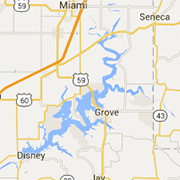Nature Conservancy protects area caves, prairies
Nature Conservancy protects area caves as well as a 20,000-acre preserve
Fire is not a bad thing according to the Preserve Director of the J.T. Nickel Family Nature and Wildlife Preserve in Tahlequah, Jeremy Tubbs.
In fact, Tubbs describes himself as a fire lover during a presentation at the Grove Rotary Club this week.
Just an hour from Grove the 20,000 acres nature preserve owned by the Nature Conservancy is using prescribed fire as a management tool to restore the prairie landscape. Tubbs says there are 16 permanent burn sites on the property that was once a cattle ranch.
For the past 19 years, this large preserve has quietly been worked on by a dedicated staff that has transformed the land from pastures and timber patches to what Native Americans saw 200 years ago.
The landscape is officially called Ozark Savanna Mosaic which includes both open prairie and a forested area of post oak and shortleaf pine.
-
Tubbs noted, "Bermuda and fescue are killed as they are not native to the area. We use herbicide to individually spray non-native plants."
In addition, the staff painstakingly collects wildflower seed and plants them throughout the prairie landscape.
"Native Americans used fire as a management tool," Tubbs said. "It replenishes plant life"
He noted that a university study shows that between 1650 and 1925 a fire burned the area every two to three years. The new plant life generated after the fire attracted turkeys, elk and deer. With also 100 years of no fires, the tree growth exploded growing from 25 to 30 trees per acre to 300 to 1,000 trees per acre."
Tubbs said this growth greatly restricted native plant growth and wildlife opportunities.
Now there are 16 permanent burn sites on the property that opens up the canopy and allow sunlight to restore the native prairie. Today 74 different species of grasses and wildflowers fill the acreage.
In terms of wildlife, black bears came back to the area in 2008. Today there are numerous bears and cubs to be seen on the walking trails. In addition, elks were reintroduced in 2005 five with 20 head placed on the property. Today it is estimated there are about 50 elk in the area.
The Illinois River flows by a portion of the property and the endangered Oklahoma salamander is protected. Also the smallest owl, the Northern Saw-Whet has migrated through the are since 2016. In 2019, several pair actually wintered on the preserve.
The trails are open during daylight hours to foot traffic only. The preserve has no facilities, and hunting, fishing, camping, dogs, and off-roading are not allowed.
The Preserve property is not the only land near Grove the Nature Conservancy manages.
Since 1978, The Nature Conservancy has protected caves in the area. Caves provide habitat for two federally-listed endangered species: the gray bat and the Ozark big-eared bat.
Twin Caves Preserve, located near the Missouri state line, features an extensive limestone cave with an underground stream and is home to rare bats and aquatic species. The Twin Caves Preserve harbors a gray bat maternity colony of more than 20,000 individuals, as well as critical habitat for the federally endangered Ozark cavefish and blind cave crayfish.
Other area caves include the Charley Owl Preserve, comprising 864 acres, near the Arkansas state line. and the Eucha Nature Preserve, located in the eastern deciduous forests of Delaware County, is a 150-acre restricted preserve encompassing two limestone caves with underground streams that support rare aquatic species including the blind cavefish and the nearly translucent Ozark crayfish.







